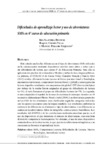Mostrar el registro sencillo del ítem
Dificultades de aprendizaje lector y uso de abreviaturas SMS en 6º curso de educación primaria
| dc.contributor.author | Saavedra Recouso, Iria | es_ES |
| dc.contributor.author | Crespo Vilas, Raquel | es_ES |
| dc.contributor.author | Peralbo, Manuel | es_ES |
| dc.date.accessioned | 2014-10-02T12:42:51Z | |
| dc.date.available | 2014-10-02T12:42:51Z | |
| dc.date.issued | 2014 | es_ES |
| dc.identifier.citation | Encuentros sobre psicología, comunicación y lenguaje, 2014: 41-59. ISBN: 978-84-9749-585-1 | es_ES |
| dc.identifier.isbn | 978-84-9749-585-1 | es_ES |
| dc.identifier.uri | http://hdl.handle.net/2183/13540 | |
| dc.description.abstract | [Resumen] Este estudio analiza las diferencias en el tipo de abreviaturas SMS utilizadas en la comunicación mediante dispositivos móviles entre niños y niñas con y sin dificultades de lectura que cursan 6º de Educación Primaria. Para ello se aplicaron dos pruebas de evaluación a 94 niños y niñas de dos colegios públicos. La primera, el EVAL EC-6 de G arcía Vidal, G onzález Manjón y G arcía Ortiz (2012) evalúa: eficiencia lectora (acceso al léxico por ruta visual y fonológica, automatización lectora), comprensión lectora (literal y global) y autorregulación lectora. A quellos estudiantes con una puntuación global 1 DT (desviación típica) por debajo de la media fueron asignados al grupo de dificultades de lectura (n=16), el resto formaron el grupo sin dificultades lectoras (n=78). L a segunda, es una adaptación al español de la tarea de escritura de mensajes situados en 10 escenarios elaborada por Plester, Wood y J oshi (2009). L as abreviaturas generadas en los SMS de los estudiantes eran clasificadas según las categorías utilizadas con los ajustes necesarios para la lengua española. L os resultados confirman la existencia de diferencias en el número y tipo de abreviaturas. L as diferencias se centran en las abreviaturas: faltas de ortografía, contracciones y homófonos. L os resultados del AN OVA y de las correlaciones realizadas muestran que no es el uso de dispositivos el que determina el número de abreviaturas, sino más bien el nivel de competencia lectora previo. N o obstante, el uso de estos dispositivos estimula el uso de la abreviación, lo que ejercita la reflexión metalingüística y en consecuencia favorece el aprendizaje lector. | es_ES |
| dc.description.abstract | [Abstract] This study analyzes the differences in the type of SMS abbreviations used in the communication via mobile devices between children with and without reading difficulties who attend Primary Education 6th. For this evaluation two tests were applied to 91 children in two public schools. The first one, the EVAL EC-6 by G arcia Vidal G arcía G onzález Manjarrez and Ortiz (2012) evaluates: reading efficiency (lexical access for visual and phonological route, reading automation), reading comprehension (literal and global) and self-reading. Students with an overall score 1 SD (standard deviation) below the mean were assigned to reading difficulties group (n = 16), the rest formed the group without reading difficulties (n = 78). The second one, is a Spanish adaptation of the task of writing messages that are located in 10 scenarios developed by Plester, Wood and J oshi (2009). The abbreviations generated in the students’ SMS were classified according to the categories used with the necessary adjustments for the Spanish language. The results confirm the existence of differences in the number and type of abbreviations. The differences center on the abbreviations: misspellings, contractions and homophones. The results of the AN OVA and correlations performed show that it is not the use of devices what determines the number of abbreviations, but the previous reading competence level. However, the use of these devices encourages the use of the abbreviation, which exercises metalinguistic and consequently promotes reading learning. | es_ES |
| dc.language.iso | spa | es_ES |
| dc.publisher | Universidade da Coruña | es_ES |
| dc.subject | Sms | es_ES |
| dc.subject | Competencia lectora | es_ES |
| dc.subject | Dificultades de lectura | es_ES |
| dc.subject | Nuevas tecnologías | es_ES |
| dc.subject | Aprendizaje lector | es_ES |
| dc.subject | Reading competence | es_ES |
| dc.subject | Reading difficulties | es_ES |
| dc.subject | New technologies | es_ES |
| dc.subject | Reading learning | es_ES |
| dc.title | Dificultades de aprendizaje lector y uso de abreviaturas SMS en 6º curso de educación primaria | es_ES |
| dc.type | conference output | es_ES |
| dc.rights.accessRights | open access | es_ES |
| UDC.coleccion | Publicacións UDC | es_ES |






